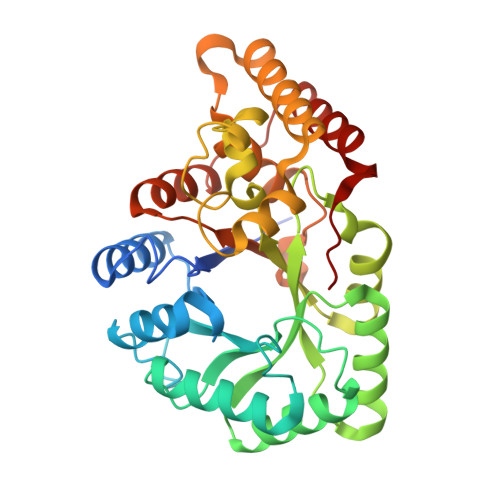Crystal Structure of Mouse Succinic Semialdehyde Reductase Akr7A5: Structural Basis for Substrate Specificity.
Zhu, X., Lapthorn, A.J., Ellis, E.M.(2006) Biochemistry 45: 1562
- PubMed: 16460003
- DOI: https://doi.org/10.1021/bi051610k
- Primary Citation of Related Structures:
2C91 - PubMed Abstract:
The aldo-keto reductases make up a superfamily of enzymes which can reduce a variety of aldehydes and ketones to their corresponding alcohols. Within each family are distinct preferences for certain substrates, presumably reflecting their role within the cell. The original member of the AKR7A subfamily was purified from liver as an aflatoxin dialdehyde reductase AKR7A1. However, recent additions to the family have revealed that even closely related enzymes have clear substrate preferences with AKR7A2, AKR7A4, and AKR7A5 showing much higher affinities for succinic semialdehyde (SSA) than does AKR7A1. To investigate the structural basis of this specificity, the crystal structure of mouse AKR7A5 has been determined to better than 2.5 A resolution. The structure is of the ternary complex of the enzyme with NADP+ and tartrate as an inhibitor. This structure has the same overall fold as the previously determined structure of AKR7A1; however, there are a number of differences in loops around the active site that contribute to observed differences in the substrate specificity between the AKR7A enzymes. Several differences are the result of bulky hydrophobic residues found in AKR7A5, namely, Met44, Trp77, and Trp224, which significantly restrict the size and modify the architecture of the substrate-binding pocket, producing a tighter or less flexible binding site for SSA than in AKR7A1. Site-directed mutagenesis was used to introduce Met44, Trp77, and Trp224 individually into AKR7A1, to test if they improved the affinity of the enzyme for SSA. Each mutation showed improved affinity for SSA, with Trp77Met having the largest effect. This confirms the role of these amino acids as substrate determinants for SSA.
- Department of Chemistry, University of Glasgow, Glasgow G12 8QQ, UK.
Organizational Affiliation:





















